The Fed Should Hike Interest Rates, Not Cut Them

In the runup to the Federal Reserve’s Open Market Committee meetings on July 30 and July 31, policy makers are debating the value of what would normally be considered unorthodox policy actions. The consequences of the Fed’s actions in the next week—the U.S. central bank is expected to cut interest rates by a quarter of a percentage point—could be with us for much longer than we think, culminating in the next recession and increasing the risk to financial stability.
In the meantime, the Fed could be delivering yet another sugar high to the economy that doesn’t address underlying structural problems created by powerful demographic forces that are constraining output and depressing prices.
By almost every measure, policy makers should be considering another rate hike, not a rate cut, in anticipation of potential economic overheating from looming limitations on output. Instead, debate has been focused on the need to take preemptive action to avoid a potential slowdown.
An abrupt shift in thinking was set in motion last December when, after raising overnight rates by a quarter of a percentage point, Fed Chairman Jerome Powell signaled more hikes would come and that balance-sheet reduction was on “autopilot.” Alarmed by the market tantrum that ensued, Fed policy makers began a mop-up campaign that included the Fed’s now-famous “pivot” to patience.
While the Fed has more than succeeded in stabilizing markets, the ensuing liquidity-driven rally in various markets has boosted asset prices, including stocks, bonds, precious metals, energy, and even cryptocurrencies.
As Europe faces prospects that negative rates might become a long-term fixture in the euro region, concerns are mounting in the U.S. that a global slide toward negative yields could infect the market for Treasury securities, should the U.S. slip into a recession. These concerns are well founded.
…click on the above link to read the rest of the article…